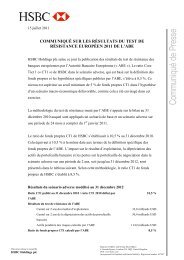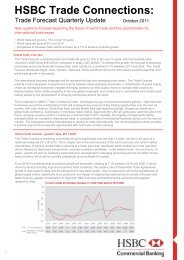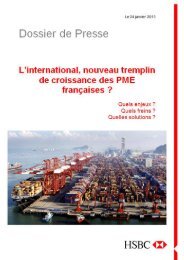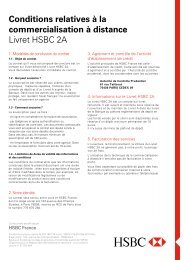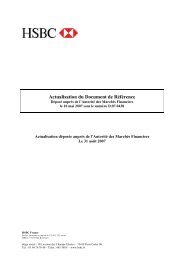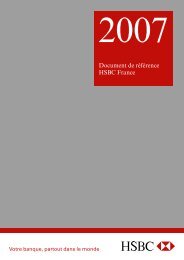The World in 2050-Quantifying the shift in the global economy - HSBC
The World in 2050-Quantifying the shift in the global economy - HSBC
The World in 2050-Quantifying the shift in the global economy - HSBC
- No tags were found...
You also want an ePaper? Increase the reach of your titles
YUMPU automatically turns print PDFs into web optimized ePapers that Google loves.
EconomicsGlobal4 January 2011abcRunn<strong>in</strong>g out of <strong>in</strong>puts?Much of <strong>the</strong> discussion about ecological capacityhas been cast <strong>in</strong> <strong>the</strong> language of ‘runn<strong>in</strong>g out’ ofkey <strong>in</strong>puts, notably energy and metals.In <strong>the</strong> case of metals, core commodities such asalum<strong>in</strong>ium, iron and even copper are widelyavailable, and easily recyclable. Even rare earthsare not so rare. Total <strong>global</strong> production <strong>in</strong> 2009 of14 key ‘rare earth’ materials amounted to 127,520tonnes. Yet, accord<strong>in</strong>g to a recent report by <strong>the</strong>US Department of Energy, <strong>global</strong> reserves standat some 99 million tonnes. <strong>The</strong> issue, however, isthat current production is highly concentrated,with 95% of output accounted for by just onecountry, Ch<strong>in</strong>a.Energy availability is somewhat morecomplicated. <strong>The</strong> era of cheap and easilyaccessible oil supplies is clearly over, with somepo<strong>in</strong>t<strong>in</strong>g to <strong>the</strong> risk of ‘peak oil’ disrupt<strong>in</strong>geconomic stability. A report on energy securityfrom <strong>the</strong> Lloyds <strong>in</strong>surance market concludes, forexample, that “we are head<strong>in</strong>g for a <strong>global</strong> oilsupply crunch and price spike”. Reserves of coaland gas are more plentiful, however. And suppliesof renewable energy are for all <strong>in</strong>tents andpurposes unlimited (and to date, untapped), atover 3,000 times larger than current energy needs.<strong>The</strong> International Energy Agency’s (IEA) latestEnergy Technology Perspectives report shows <strong>in</strong>its BLUE Map scenario that it is possible to raiseenergy production by <strong>2050</strong> while simultaneouslyreduc<strong>in</strong>g coal, oil and gas consumption belowcurrent levels (Chart 32).Indeed, for an additional upfront cost ofUSD46trn <strong>in</strong> energy efficiency, renewables,nuclear and ‘clean coal’, fuel sav<strong>in</strong>gs amount<strong>in</strong>g32. A low-carbon future <strong>in</strong> <strong>2050</strong> will use less energy than ‘bus<strong>in</strong>ess as usual’ <strong>in</strong> 2030: world primary energy supply by fuel (BoE)2400022000200001800016000O<strong>the</strong>rBiomass and w asteHy droNuclearNatural gasOilCoal140001200010000800060004000200002007 Basel<strong>in</strong>e 2030 Basel<strong>in</strong>e <strong>2050</strong> BLUE Map <strong>2050</strong>Source: IEA, Energy Technology Perspectives 201025



